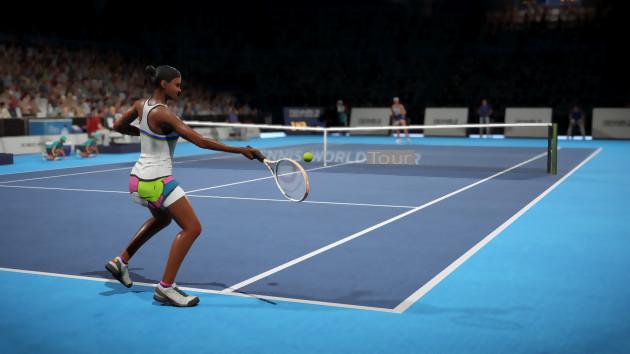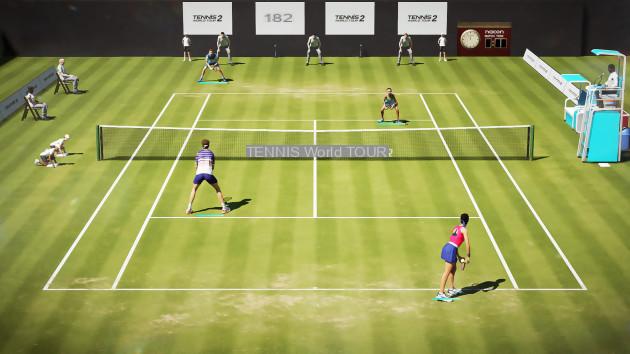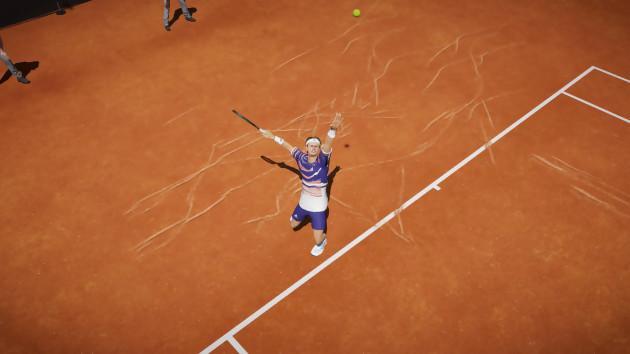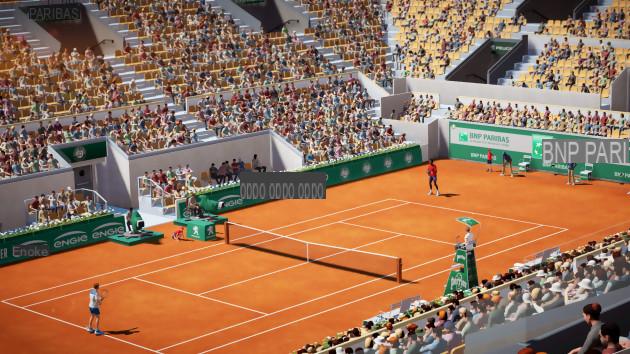
The lack of timing in Tennis World Tour is an aberration that Big Ant Studios hastened to erase. This time, an indicator lets you know if you typed “too early” or “too late”, the goal being to regularly hit “good” and “perfect”. To achieve this, one must first distinguish between precise blows and powerful blows. The former are valuable for finding angles and offsetting the opponent, while the big strikes are generally used to outflank him, and therefore to conclude the point. Depending on the type of shot that will be executed, it will be necessary to type differently. Basically, in the case of a precise strike, the key should be pressed briefly just before the ball makes contact with the racket; while if you want to send a praline, you will have to hold the button and release it before impact. Simple on paper, the manipulation is more difficult to implement because, inevitably, there are other factors to take into account. For example, we will not apprehend a flat ball as a sliced or topspin shot. Surface and climate can also affect rebound or spin, not to mention positioning. Unlike AO Tennis 2, which fixed the timing, the game leaves room for maneuver so as not to discourage the less adventurous. More concretely, if we miss when initiating a precise shot, the ball will still remain in the court. In fact, only ill-fitting caramels are likely to go out of bounds, which seems logical.
So yes, it's not the prettiest game in the world, but when it comes to gameplay, Big Ant Studios has got something on which it can build.
Anyway, Tennis World Tour 2 is less predictable, less Cartesian than Top Spin 4; one of the many promises the first episode failed to deliver. With the 2K Sports simulation, as soon as you took the lead, you knew the point was won before the rally was even over. The system left no room for uncertainty: once you had identified all the priorities – like in a fighting game – you became unplayable. In Tennis World Tour 2, even when you're on the verge of breaking, there is a way to reverse the balance of power with a spin used wisely, or a perfect strike. Clearly, the game leaves a chance to catch up, even if it means abusing at times; because the AI that shoots a comet while being at the net, at the end of the race, and with a weak rebound, it clearly comes from space. Since we approach the things that annoy, despite the efforts of Big Ant Studios, the physics engine remains perfectible. Some trajectories are unclear, and player inertia still needs tweaking. Whether you're on clay, grass, hard or carpet, you feel like you're sliding on the court instead of having your feet firmly planted on the ground. Under these conditions, the movements are sorely lacking in consistency. With timing that now has a say, we would have appreciated small adjustment steps to better position ourselves in relation to the ball.
ICT & TOC
There is also the AO Tennis 2 syndrome, i.e. the player who freezes when he is able to catch the ball; and it is a phenomenon that often occurs, as if it were forbidden to make a low volley, a half-volley or to return a powerful serve. Frustrating. Same for the smashes which are imperatively done with a rebound, never without. But the worst is when our player automatically advances towards the net when the ball falls at midcourt. We may have looked in the options to deactivate a possible assistance, impossible. It's a shame, because this arbitrary choice ruins an important aspect of tennis in addition to stupidly losing points. This ineptitude highlights that the volley has not improved in quality since the Tennis World Tour, which does not really make you want to go to the net, or spend time on the automatically included double. Despite everything, we are happy to be able to hit the ball with a certain logic. When we screw up, we know why. Moreover, with such a solid foundation, we do not hesitate to raise the difficulty to "Expert" to force ourselves to vary our game. This is where we became familiar with the subtleties of the service and its system. double reticle rather well thought out. By placing the cursor in each of them, we ensure maximum power; and behind, you have to target an area of the opposite service box to increase your chances of making an ace.

Of course, nothing requires taking risks, and you can very well play it safe by pressing the button first, then a second time. On this subject, we noticed that the AI also tended to opt for security on the second service. So much the better, because the first ball arrives so quickly in "Expert" (especially with John Isner) that it is a torture to send it back; or else, you have to anticipate by leaving one side open. We don't know if it's deliberate, but it probably deserves to be a little more balanced so as not to have the feeling of facing a peno. On the other hand, nothing to say about the amortization which delights when it is perfectly executed from the baseline. As for the more nervous rhythm, it reinforces this feeling of satisfaction when you conclude a point. You will therefore have understood, in terms of gameplay, Tennis World Tour 2 is not the dreaded disaster, although by force, the players all end up looking the same. Understand by this that Nadal's solidity from the baseline, Federer's address on the fly, or Wawrinka's devastating backhand are not obvious. With the exception of large servers, the game fails to transcribe the singularity of each. Perhaps because we now have control over the cards that grant a boost or weaken the player opposite depending on the course of the match. Immovable in Tennis World Tour, the decks (up to five) can be modified this time, a store allowing to buy more or less expensive packs (silver, gold, diamond).
There is also the AO Tennis 2 syndrome, i.e. the player who freezes when he is able to catch the ball; and it is a phenomenon that often occurs, as if it were forbidden to make a low volley, a half-volley or to return a powerful serve.

Those who spit on micro-transactions can rest assured, the cards can only be purchased with in-game currency that is accumulated by completing optional objectives during matches, or by taking part in competitions. Note that two types of cards are available: those whose effects last throughout the encounter (support), and those whose impact is only palpable over a short period of time (dynamic). Their use is limited, just to consume them with a minimum of reflection. If we are aware that Big Ant Studios wanted to add a tactical dimension to Tennis World 2, the cards are not of much use in the end. Indeed, we much prefer to concentrate on our game than to try to screw up that of the adversary. And hey, when you pretend to be a simulation, that kind of mechanic doesn't really make sense. In any case, on the casting side, we are entitled to 36 stars of the discipline, plus Marat Safin and Gustavo Kuerten if we pre-ordered the standard version (49,99€) or yielded to the sirens of the Ace edition (69,99, 1€). Two flats: 11) With only 2 representatives, women are still outnumbered, XNUMX) The Williams sisters, Novak Djokovic or Andy Murray are conspicuous by their absence. Afterwards, the developers have already planned to add other players via DLC; it is therefore not impossible to see them arrive later.
NEW BALES REQUESTED
In the meantime, we have a look at the “Career” mode which, it must be admitted, does not bring anything new compared to the first Tennis World Tour. Yes: we can finally customize our avatar as we see fit, instead of stuffing ourselves with predefined athletes. For the rest, it is always a question of integrating the world elite by climbing the ranking according to the rules laid down by the ATP/WTA. Naturally, the XP points collected continue to feed the famous archetypes (attack, defense, precision), and suddenly the attributes (stamina, forehand, backhand, power, volley among others) of our colt. Just like on the court, fatigue management is essential: when you pull too much on the rope, an alert is displayed on the screen to avoid any injury, even if it means abandoning a tournament. It is certainly not the possibility of signing sponsorship contracts or with coaches that will allow you to vary the pleasures. Perhaps scripting all of this – complete with well-crafted cut scenes – is something Big Ant Studios should look at to freshen up the formula.
In addition, it should be recognized that the series has made some progress on the visual level. OK, the public is still a little scary, some close-ups are unsightly, and the facial expressions are frozen. But besides that, the developers have worked on the modeling of the players: when we compare to Tennis World Tour, there is a clear evolution. Big Ant Studios hasn't contented itself with erasing the shameful bugs of the first opus, it has also added new animations which make the players more fluid in their movements, and less lambda too. Special mention to Nadal's toc just before serving. There is still work to do, we are not going to lie to each other – for the signature gestures, we will have to go back – but the nightmare of 2018 is well and truly behind us. Finally, Guy Forget was not asked this time. So much the better, because the comments didn't fly very high, and it allows you to better realize the attention paid to sound design.


























